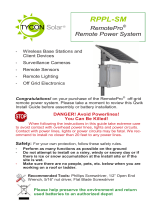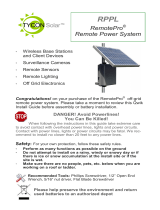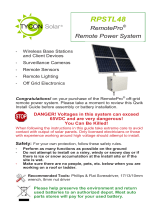
RPPL-LG PWM
RemotePro® Outdoor
Solar Power System
▫ Wireless Base Stations
and Client Devices
▫ Surveillance Cameras
▫ Mission Critical Backup
Power
▫ Remote Sensors
Congratulations! on your purchase of the RemotePro® Outdoor
Off-Grid solar power system. Please take a moment to review
this Qwik Install Guide before assembly or battery installation.
DANGER! Avoid Powerlines!
You Can Be Killed!
When following the instructions in this guide take extreme care
to avoid contact with overhead power lines, lights and power circuits.
Contact with power lines, lights or power circuits may be fatal. We rec-
ommend to install no closer than 20 feet to any power lines.
Safety: For your own protection, follow these safety rules.
▫ Perform as many functions as possible on the ground
▫ Do not attempt to install on a rainy, windy or snowy day or if
there is ice or snow accumulation at the install site or if the
site is wet.
▫ Make sure there are no people, pets, etc. below when you are
working on a roof or ladder.
Recommended Tools: Phillips Screwdriver, Flat Blade Screw-
driver, 5/16 nut driver
Please help preserve the environment and return
used batteries to an authorized depot

2
Qwik Install
STEP 1: Prepare Enclosure - Attach Battery Brackets
Prepare the Velcro strap and the strap brackets,
#5600066. Orient as shown.
Loosen 8 screws holding the mounting plate.
Slide the mounting plate towards you and lift up
on the top end of the mounting plate while sliding
the #5600066 brackets with Velcro Straps over
the end of the mounting plate.
Place the brackets as shown (approx 1.75”
from the enclosure walls) and attach to the
mounting plate using Qty 4 #8 x 3/8 pan
head self tapping screws.
Tighten the Qty 8 mounting plate attach
screws.
Position the #5600067 Battery Support
Brackets ~7” from the top of the enclosure.
Attach to the mounting plate using Qty 6 #8 x
3/8 pan head self tapping screw. Note: The
farthest left and right screw holes won’t be
used.
Route the Velcro straps through the slot in
the #5600067 brackets. We recommend not
installing the batteries at this time because it
makes the enclosure heavy and harder to
handle. We suggest installing the batteries once the enclosure is al-
ready mounted to a pole or wall.
STEP 2: Prepare Enclosure - Attach Pole Mount Brackets
Caution: Pole mount brackets may have sharp edges, wear gloves.
Attach the pole mount
brackets to the back of the
enclosure using four flat
washers as spacers under
the bracket and four flat
washers and self tapping
screws on top of the brack-
et per the instructions that
came with the enclosure.

3
STEP 3: Solar Battery Charge Controller Install
The system includes an ad-
vanced PWM charge control-
ler with 20A load output.
Mount the controller on the
backplate using one or two #8
x 3/8” pan head self tapping
screws. The mounting holes in
the controller don’t match ex-
actly to the backplate holes.
You can angle the controller to
align two mounting holes. You
can also mount the controller
to the inside cover using vel-
cro tape if you need more
room on the backplate to
mount your equipment.
The controller maintains prop-
er charge parameters to ex-
tend battery life.
Attach the included battery
cables to the controller BAT
inputs. (Red to + and Black
to –). Don’t connect wires to
battery until battery install
step.
Note: The battery cable is
different if 12V or 24V con-
figuration. For 12V, all bat-
teries are wired in parallel. If
24V, each pair of batteries
is wired in series and both
series pairs are wired in
parallel.
The kit includes two Cable Gland Feed-
throughs. Remove one or two hole plugs in the
bottom of the enclosure and replace with one
or two cable gland feedthroughs to be used to
route external wires.
STEP 4: Solar Assembly
Assemble the solar mount bracket per the in-
structions that came with the solar mount and
attach the solar panel with solar panel junction
box toward the top or left/right side.

4
Set the bracket angle for your optimum winter angle (Latitude * 0.9 + 30
degrees)
Install the solar assembly to a 2” to 4” pole. Solar panel should be fac-
ing South if in Northern Hemisphere. Avoid any shading of solar panel.
STEP 5: Enclosure Mounting
Mount the enclosure to a pole using two stainless steel hose clamps.
Cut off any extra hose clamp length after tightening to keep a clean in-
stall. As an option, the enclosure can also mount to a wall using the
included 4 wall mount brackets and user supplied screws. It’s best to
mount the enclosure so it is shaded by the solar panel.
Route the solar cable through one of the feedthrough in the bottom of
the enclosure and to the PWM solar controller solar panel inputs. Be
careful to observe proper polarity. Red wire to + and Black wire to –.
Don’t plug the external solar connectors until the system startup step.
STEP 6: Battery Install
Insert the batteries by slipping under the Velcro straps. Attach all cables
to the batteries and then tighten the straps.
Connect Battery wire negatives (Black) to battery terminal negatives
(Black). Connect Battery wire positives (Red) to battery terminal posi-
tives (Red).
The Velcro straps will be on top of the connectors. This is the normal
configuration.
STEP 7: System Startup
Once the battery is connected the solar controller display should turn
on.
Plug in the external MC-4 solar connectors. Connect negative (-) con-
nector first.
STEP 8: Finalize the Install
Make sure the lid gasket is clean and free from any particles, then close
and latch the cover, making sure that wires are clear of the gasket area.
There is a small combination lock included if you want to prevent some-
one from opening the enclosure without your knowledge.

5
12V Battery Configuration
24V Battery Configuration

6
TECH CORNER
1. CONTROLLER: In 12V mode, the controller turns off power to the
load at 11V and reconnects when the battery reaches 12V. In 24V
mode, the controller turns off at 20V and on at 24V. This protects the
batteries from overdischarge and increases battery life and perfor-
mance.
2. CAPACITY: The RemotePro® with 4 AGM battery provides 432Wh of
backup power.
3. BATTERY MAINTENANCE: The batteries used in the RemotePro®
systems don’t require any maintenance. AGM should last up to 5 years
in normal use. Note: Never store batteries for any length of time in a
discharged state or it will damage the battery.
4. BATTERY OVERDISCHARGE: We highly recommend hooking all
SPECIFICATION SUMMARY
Subject to change without notice
Model #
Continuous Power
Generation*
Reserve Time
Battery Voltage
AGM Battery
Capacity
Solar Size
RPPL12-36-35 7.5W 28hrs 12V 36Ah 35W
RPPL24-36-30 6.5W 33hrs 24V 36Ah 30W
Lead Acid
Battery
Model #
Continuous Power
Generation*
Reserve Time
Battery Voltage
Battery
Capacity
Solar Size
RPPL12-40L-35 7.5W 48hrs 12V 40Ah 35W
RPPL12-40L-85 15W 24hrs 12V 40Ah 85W
RPPL24-40L-30 6.5W 55hrs 24V 40Ah 30W
Lithium
Battery

7
equipment loads to the controller load outputs. These outputs will dis-
connect the load if the battery voltage drops below 11V/20V and this
will protect the battery from over-discharge. If batteries get completely
discharged, you will reduce the battery life and you will need to super-
charge them with a good quality 10A automotive battery charger. Don’t
charge for more than 8hrs on an automotive charger. Once they are
back to a normal operating range, the integrated charge controller will
maintain the charge.
5. TROUBLESHOOTING:
A. There is no Load Output?— The load output is turned off by the
button on the controller -or- If battery voltage is too low, the charge
controller will turn off the load outputs. On a 12V battery system the
load will turn off if battery is <11V. On a 24V battery system the
load will turn off at <20V. It won’t turn back on until the battery volt-
age exceeds 12V/24V.
B. I want to add additional solar panels. What is the largest solar
panel I can use? Max Solar Panel Size = 12V battery: 200W ,
24V battery: 400W
C. The voltage shown on the controller is 12V but my batteries
are wired for 24V? The PWM controller ships in Auto voltage
configuration. It will automatically detect the correct voltage. If the
batteries are wired for 24V but the battery voltage is too low, the
controller may think the connected battery is 12V. In this case,
refer to the controller manual and set the controller for 24V battery
instead of Auto.
6. ACCESSORIES: Tycon® offers a variety of accessories to meet al-
most any need. Just visit tyconsystems.com for more info.
Limited Warranty
The RemotePro® products are supplied with a limited 36 month warran-
ty which covers material and workmanship defects. This warranty does
not cover the following:
▫ Parts requiring replacement due to improper installation, misuse, poor site
conditions, faulty power, etc.
▫ Lightning or weather damage.
▫ Physical damage to the external & internal parts.
▫ Products that have been opened, altered, or defaced.
▫ Water damage for units that were not mounted according to user manual.
▫ Usage other than in accordance with instructions and the normal intended
use.
NOTES

8
8000121 Rev 1 RPPL-LG PWM RemotePro® Qwik Install Guide
-
 1
1
-
 2
2
-
 3
3
-
 4
4
-
 5
5
-
 6
6
-
 7
7
-
 8
8
TYCON Solar RPPL24-36-30 User guide
- Type
- User guide
- This manual is also suitable for
Ask a question and I''ll find the answer in the document
Finding information in a document is now easier with AI
Related papers
-
 TYCON Solar RPPL1248-36-35 User guide
TYCON Solar RPPL1248-36-35 User guide
-
 TYCON Solar RPPL1224-20L-35 User guide
TYCON Solar RPPL1224-20L-35 User guide
-
 TYCON Solar RPPL2424-36-30 User guide
TYCON Solar RPPL2424-36-30 User guide
-
 TYCON Solar RPPL1248-36-35 User guide
TYCON Solar RPPL1248-36-35 User guide
-
 TYCON Solar RPPL12-36-35-PUMP User guide
TYCON Solar RPPL12-36-35-PUMP User guide
-
 TYCON Solar RPS12-100-85 User guide
TYCON Solar RPS12-100-85 User guide
-
 TYCON Solar RPSTL12/24M-400-340 User guide
TYCON Solar RPSTL12/24M-400-340 User guide
-
 TYCON Solar RPSTL12/48M-400-720 User guide
TYCON Solar RPSTL12/48M-400-720 User guide
-
 TYCON Solar RPS12M-100L-85 User guide
TYCON Solar RPS12M-100L-85 User guide
-
 TYCON Solar RPSTL48-400-720 User guide
TYCON Solar RPSTL48-400-720 User guide
Other documents
-
 ATEM POWER VASPZHI User manual
ATEM POWER VASPZHI User manual
-
Tycon Systems 5600033 Datasheet
-
Tycon Systems UPS-PL2448HP-18 Installation guide
-
Tycon Systems UPS-DC1224-9 Installation guide
-
Tycon Systems UPS-ST12-50 Installation guide
-
Tycon Systems UPS-ST2424-50-UBNT Installation guide
-
Renogy STARTER50P User manual
-
Bogart Engineering SC-2030 Technical Manual
-
Vetus Solar charger type SL Installation guide
-
Morningstar ProStar PS-15 User manual


















